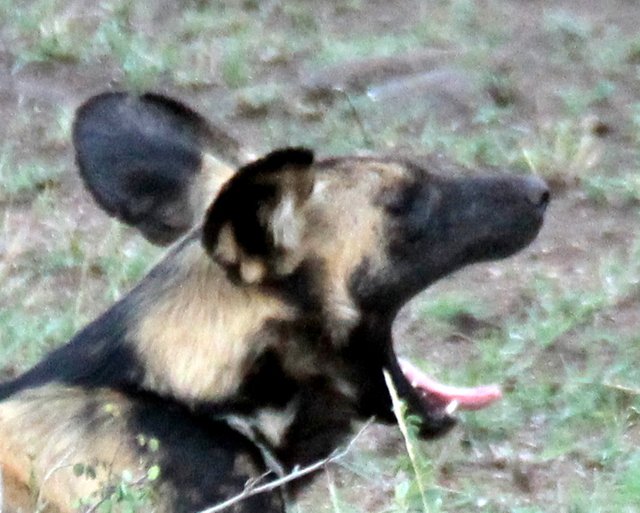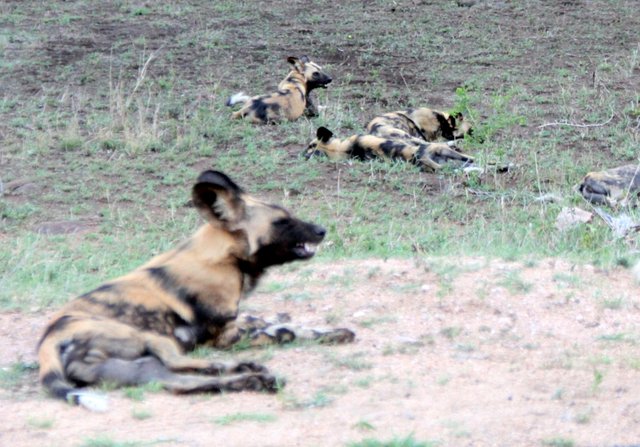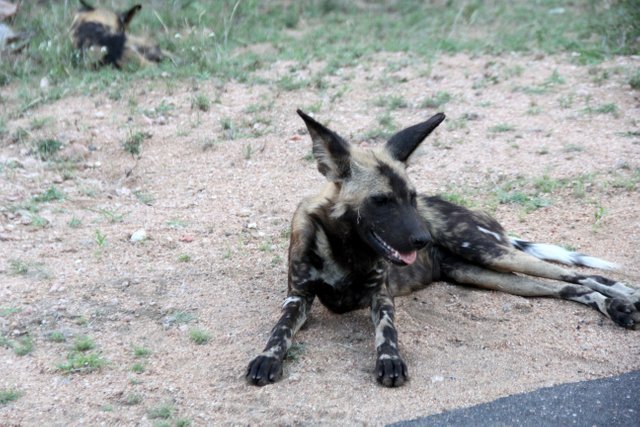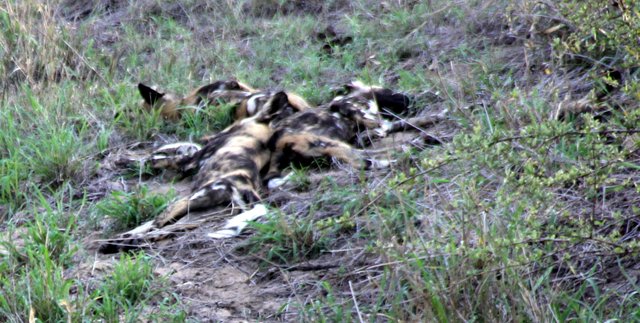AFRICAN WILD DOGS
THE AFRICAN WILD DOG is one of Africa's most endangered mammal species.
Various factors contribute to this poor conservation status.
The main contributory factor to the decline in population numbers is persecution by mankind, until recently even within conservation areas.
Other factors are diseases like rabies and distemper where Wild Dogs came in contact with domestic animals.
Genetic inbreeding may be the possible cause of the Kruger National Park Wild Dog's life expectancy of only 6 years.
The estimated decline in African Wild Dog population size can be uncertain due to the species’ tendency to population fluctuations.
In South Africa, we have fewer than 550 roaming our wild spaces .
African Wild Dogs need large areas to support themselves and for populations to be genetically diverse and sustainable.

This carnivore is a member of the dog family, and measures 750mm at the shoulders.
Males are slightly larger than females and weigh 20-30 kg as adults.
It has a blotchy yellow, black and white coat.
Each individual has a unique coat pattern, which makes it possible to identify every individual in a population with certainty.
One is very lucky to come across a pack of wild dogs like this.
The major reasons why African Wild Dogs are so endangered are reasonably well understood.
These include extreme sensitivity to habitat fragmentation as a consequence of wide-ranging behaviour, conflict with livestock and game farmers, accidental killings by snares and road accidents, and infectious disease.
All of these causes are associated with human encroachment on African Wild Dog habitat.

Poaching is one of the reasons why African Wild Dogs are so endangered?
Most of our planet’s wildlife is found in poorer, rural areas.
Poaching and the illegal meat trade is rife in most of Africa.
One of the many methods used to catch wild animals for food, is snaring.
The target prey of hunters is generally antelope but snares often end up fatally wounding endangered wildlife instead.
African Wild Dogs are particularly susceptible to being caught as bycatch in the snares set by poachers.
If one dog gets caught in a snare, the rest of the pack are most likely to go back to find the missing individual.
This often leads to other endangered African Wild Dogs being caught if several snares have been set in the same area. An entire pack can be killed.
African Wild Dog Monitoring
Wildlife monitoring is an effective way of keeping track of the movements of African Wild Dogs, understanding demographics, and learning about their ecology and population structures.
Studying and recording behavioural, social, and feeding patterns of African Wild Dogs is beneficial for research purposes.
Intensive, daily wildlife monitoring allows us to predict future movements and possible dispersals of individuals from their packs.

African Wild Dog tracking collars allow us to detect if any individuals have left the confines of a wildlife park. This allows us to act immediately to bring them back, and helps prevent conflict and interaction with humans and domesticated animals. Disease outbreaks of Rabies, Parvo or Distemper virus passed on by domesticated animals, is another significant reason why African Wild Dogs are so endangered.
Daily Wild Dog monitoring allows us to pick up on poaching incidences quickly, as well as injuries from fighting, snares and predation..
Data helps to evaluate Wild Dog conservation efforts.
Without it we have no baseline data for comparison. Information gathered allows for informed decision making around African Wild Dog conservation.
If we understand the reasons for previous population declines, we can adjust management practices where possible. In doing so, we can help restore African Wild Dog numbers.

A lack of accurate and extensive data to help wildlife management make informed decisions around endangered species conservation, is one of the reasons why African Wild Dogs are so endangered.
Wildlife ACT has been helping to gather and collate such data for the past ten years and has intensified this process by enlisting the help of wildlife conservation volunteers.
Those who participate in our Endangered Species Monitoring programme, are not only helping make a vital contribution towards Africa Wild Dog conservation, but towards other endangered wildlife species as well.
All photographs are mine, except for the photo of the ranger and the dog with the collar.
The information about wild dogs I obtained from the Internet, from a few different web sites.




/ᐠ._.ᐟ\